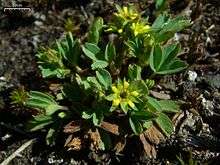Sibbaldia procumbens
Sibbaldia procumbens is a species of flowering plant in the rose family known by the common name creeping sibbaldia.[1] It has a circumpolar distribution; it can be found throughout the northern latitudes of the Northern Hemisphere from Arctic regions into higher-elevation temperate areas. It grows on tundra and in alpine climates where snow remains year-round, and on subalpine mountain slopes. This is a low, mat-forming perennial herb producing clumps of herbage in rocky, gravelly substrate. A spreading stem up to 15 centimeters long grows from a caudex. Each leaf is divided into usually three leaflets borne at the end of a petiole up to 7 centimeters long. Each wedge-shaped leaflet has three teeth at the tip. The flower has usually five pointed green bractlets, five wider pointed green sepals, and five tiny yellowish petals each about a millimeter long. The fruits develop in the remnants of the sepals on erect stalks.
| Sibbaldia procumbens | |
|---|---|
 | |
| Scientific classification | |
| Kingdom: | Plantae |
| Clade: | Tracheophytes |
| Clade: | Angiosperms |
| Clade: | Eudicots |
| Clade: | Rosids |
| Order: | Rosales |
| Family: | Rosaceae |
| Genus: | Sibbaldia |
| Species: | S. procumbens |
| Binomial name | |
| Sibbaldia procumbens | |
| Synonyms | |
|
Potentilla sibbaldii | |
This Arctic plant was made into a tea by the Inuit, who called it arpehutik.[2]
References
- "Sibbaldia procumbens". Natural Resources Conservation Service PLANTS Database. USDA. Retrieved 12 November 2015.
- Flora of the Canadian Arctic Archipelago
External links
- Jepson Manual Treatment
- Washington Burke Museum
- Southwest Colorado Wildflowers
- Photo gallery
